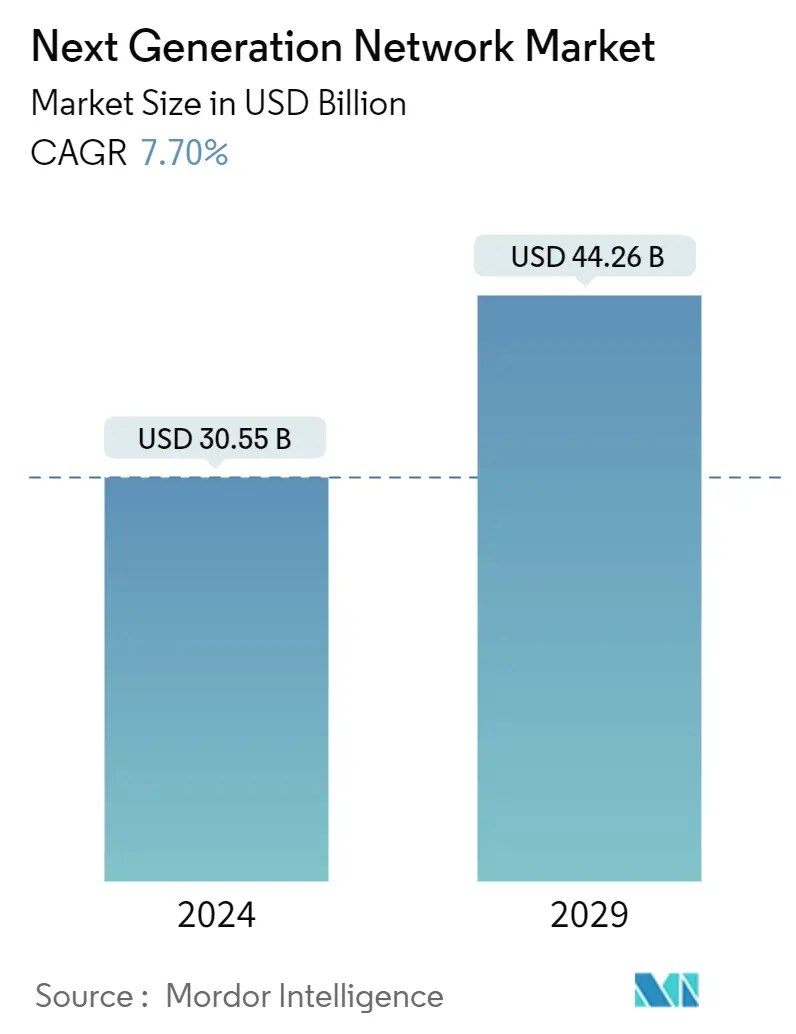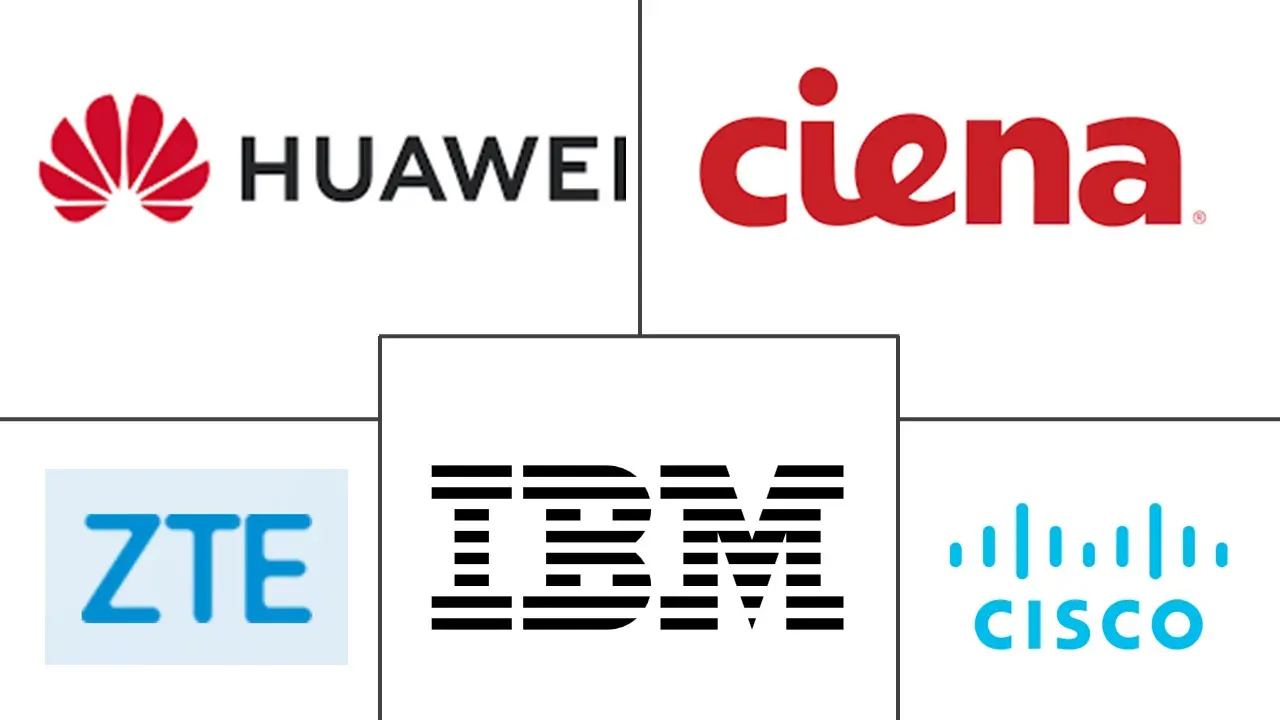Market Size of Next Generation Network Industry

| Study Period | 2019 - 2029 |
| Market Size (2024) | USD 30.55 Billion |
| Market Size (2029) | USD 44.26 Billion |
| CAGR (2024 - 2029) | 7.70 % |
| Fastest Growing Market | Asia Pacific |
| Largest Market | Asia Pacific |
Major Players
*Disclaimer: Major Players sorted in no particular order |
Next Generation Network Market Analysis
The Next Generation Network Market size is estimated at USD 30.55 billion in 2024, and is expected to reach USD 44.26 billion by 2029, growing at a CAGR of 7.70% during the forecast period (2024-2029).
A next-generation network is a packet-based network used for telephony and data. It uses numerous broadband and quality of services (QoS) transport technologies to create advanced communication systems. These networks are capable of handling multiple types of services/traffic, such as voice, video, audio, and other multimedia, in a single platform and are cost-effective in the long run.
• The increasing need for bandwidth is driving market growth. Data generation and consumption are increasing rapidly due to the increased activities such as streaming, gaming, virtual reality, and cloud-based applications, increasing strain on traditional networks and leading to slowdowns and congestion.
• The rapid growth in rolling out of 5G from numerous telecom companies globally also adds to the market growth. The next generation of telecom networks, or 5G, has grown significantly in the past few years and continuously expands. For instance, in December 2023, Huawei stated that its 5.5G Intelligent Packet Core Network offering had accepted the Next-Generation Mobile Internet to support an intelligent 5.5G core network. The company has made these changes in response to the rising necessity for 10 Gbps pipes and network intelligence.
• Software-defined networks are powering the next generation of government networks undergoing transformation. As government agencies are realizing the benefits of using SDN to build software-defined wide-area networks (SD-WAN) at lower cost, the development of this network is anticipated to drive market growth.
• However, the market is facing many challenges, such as complete compliance and inter-networking with a broad range of IPv4, MPLS, IPv6, metro Ethernet, and networking standards, on-time delivery of packet-based software to address requirements for NGN equipment, software investments across diverse hardware platforms in the rapid technologically evolving market. All these factors are expected to challenge the growth in the next-generation network market.
• The rapid change in the technology landscape is also transforming the services landscape, paving the way for next-generation services and resilient network operations post-pandemic. Remote deployment support, remote Network Operations Center (NOC) management, and predictive maintenance are becoming a necessity.
Next Generation Network Industry Segmentation
The next-generation network market is defined based on the revenues generated from the sale of hardware, software, and services by key vendors across the world.
The next-generation network market is segmented by offering (hardware, software, and services), end user (telecom and internet service providers, government, and other end users), and geography (North America, Europe, Asia-Pacific, Latin America, and Middle East and Africa). The report offers market forecasts and size in value (USD) for all the above segments.
| By Offering | |
| Hardware | |
| Software | |
| Services |
| By End User | |
| Telecom and Internet Service Providers | |
| Government | |
| Other End-users |
| By Geography | |
| North America | |
| Europe | |
| Asia-Pacific | |
| Latin America | |
| Middle East and Africa |
Next Generation Network Market Size Summary
The next-generation network market is poised for significant expansion, driven by the increasing demand for advanced communication systems that can handle diverse services such as voice, video, and multimedia on a single platform. This growth is largely fueled by the rising need for higher bandwidth to support activities like streaming, gaming, and cloud-based applications, which are straining traditional networks. The rollout of 5G technology by telecom companies worldwide further propels market growth, as these networks require sophisticated infrastructure to manage higher data speeds and improved network intelligence. Additionally, the adoption of software-defined networks (SDN) is transforming government networks, offering cost-effective solutions that are expected to contribute to market expansion. However, challenges such as compliance with various networking standards and the need for timely software delivery pose obstacles to growth.
The demand for next-generation network hardware, including switches, routers, and security devices, is driven by the surge in data traffic and the need for robust infrastructure to support IoT, 5G, and edge computing. This hardware is essential for ensuring high-speed, secure, and reliable networking, which is crucial as digital landscapes evolve. The market is characterized by the presence of major players like Cisco, Huawei, and IBM, who are employing strategies such as acquisitions and partnerships to enhance their offerings and maintain a competitive edge. Regional developments, particularly in Europe and Asia-Pacific, are also contributing to market growth, with countries like South Korea and Japan investing in next-generation solutions to meet digital goals. These initiatives, along with advancements in optical technology and collaborations between telecom companies and technology firms, are expected to drive the market forward, addressing the increasing demand for high-capacity, low-latency communication solutions.
Next Generation Network Market Size - Table of Contents
-
1. MARKET INSIGHTS
-
1.1 Market Overview
-
1.2 Market Drivers
-
1.2.1 Increasing Demand for High-Speed Services
-
-
1.3 Market Restraints
-
1.3.1 High Costs Related to the Infrastructure
-
-
1.4 Industry Attractiveness - Porter's Five Forces Analysis
-
1.4.1 Threat of New Entrants
-
1.4.2 Bargaining Power of Buyers/Consumers
-
1.4.3 Bargaining Power of Suppliers
-
1.4.4 Threat of Substitute Products
-
1.4.5 Intensity of Competitive Rivalry
-
-
1.5 Impact of COVID-19 on the Next-generation Network Market
-
-
2. MARKET SEGMENTATION
-
2.1 By Offering
-
2.1.1 Hardware
-
2.1.2 Software
-
2.1.3 Services
-
-
2.2 By End User
-
2.2.1 Telecom and Internet Service Providers
-
2.2.2 Government
-
2.2.3 Other End-users
-
-
2.3 By Geography
-
2.3.1 North America
-
2.3.2 Europe
-
2.3.3 Asia-Pacific
-
2.3.4 Latin America
-
2.3.5 Middle East and Africa
-
-
Next Generation Network Market Size FAQs
How big is the Next Generation Network Market?
The Next Generation Network Market size is expected to reach USD 30.55 billion in 2024 and grow at a CAGR of 7.70% to reach USD 44.26 billion by 2029.
What is the current Next Generation Network Market size?
In 2024, the Next Generation Network Market size is expected to reach USD 30.55 billion.

